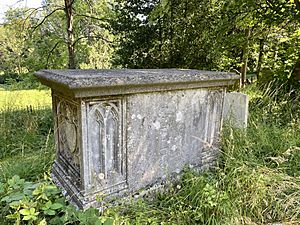Joseph Ayloffe facts for kids
Sir Joseph Ayloffe, 6th Baronet (FRS, FSA) was an English antiquary born in 1708. He passed away on April 19, 1781, in London. An antiquary is someone who studies old objects and historical records. Sir Joseph was very interested in the past and helped preserve important historical documents.
Sir Joseph Ayloffe's Early Life and Family

Joseph Ayloffe was born in Sussex, England. He was the great-grandson of Sir William Ayloffe, 1st Baronet. A baronet is a special title, like a knight, that can be passed down through a family. Joseph's father was also named Joseph Ayloffe, a lawyer.
Joseph went to Westminster School, a famous school in London. Later, he studied law at Lincoln's Inn in 1724. He also spent some time at St John's College, Oxford. In 1730, he became the 6th Baronet Ayloffe after his cousin, Sir John Ayloffe, passed away. When Sir Joseph died, the baronetcy ended because he had no more sons to inherit the title.
Sir Joseph's Work as an Antiquary
From a young age, Sir Joseph was fascinated by antiquities, which are ancient objects and historical studies. He quickly became known among learned people, even though he didn't publish much at first.
In 1732, he was elected a member of the Society of Antiquaries of London, a group dedicated to studying history. He also became a member of the Royal Society in the same year. Seven years later, he joined the Spalding Gentlemen's Society, another group interested in learning.
Sir Joseph didn't only focus on old things. He also held important public jobs.
- From 1736 to 1737, he helped manage the building of Westminster Bridge.
- In 1750, he was an auditor for the Bethlehem and Bridewell hospitals.
- In 1763, he became one of three keepers of the State Paper Office. This office was responsible for keeping important government documents.
In 1751, Sir Joseph played a big part in getting a special charter for the Society of Antiquaries. This charter made the society an official organization. He was also a vice-president of the society for many years and often shared his research at their meetings.
Sir Joseph was good friends with Thomas Astle, who worked with him at the State Paper Office, and Richard Gough, another famous antiquary. Richard Gough even called Ayloffe the "English Montfaucon," comparing him to a very famous French historian.
Sir Joseph Ayloffe passed away in Kensington on April 19, 1781. He had one son, who sadly died young in 1766. Both Sir Joseph and his son were buried in Hendon churchyard.
Sir Joseph Ayloffe's Published Works
Sir Joseph started publishing his writings later in life. Some of his projects didn't become very popular.
In 1751, he planned to print old parliamentary debates, but not many people supported the idea. He also tried to translate a famous French encyclopedia called the Encyclopédie by Diderot and D'Alembert. He wanted to add more English information, but this project also didn't get enough support and was stopped.
However, Sir Joseph did publish some important works.
- In 1748, he worked with Joshua Kirby, an artist, to publish engravings of buildings and monuments in Suffolk. Sir Joseph wrote the descriptions for these pictures. He had hoped to use these drawings in a larger history book about Suffolk, but he didn't receive enough support to finish it.
Sir Joseph also wrote several articles for Archæologia, the journal of the Society of Antiquaries. These articles were highly valued.
- In 1763, he shared an interesting old document from 1563 about people making portraits of Queen Elizabeth.
- In 1773 and 1774, he wrote about three important historical paintings:
- A painting at Windsor showing a meeting between Henry VIII and Francis I.
- Four paintings at Cowdray that showed Henry VIII's wars in France.
- The opening of the tomb of Edward I at Westminster Abbey in 1774. Sir Joseph helped supervise this event.
Another paper he wrote for the Society of Antiquaries was about five monuments in Westminster Abbey. It was published separately in 1780. He also wrote an account of a chapel on London Bridge, which was published in 1777.
One of his most important works for history students was published in 1772: Calendars of the Ancient Charters, and of the Welsh and Scottish Rolls, Now Remaining in the Tower of London. This book, with an introduction by Thomas Astle, talked about the history of important government documents called Public Records. Sir Joseph encouraged scholars to study these old papers.
Sir Joseph also helped prepare new editions of other important historical books, like John Leland's Collectanea (1771) and the Liber Niger Scaccarii (1771). He added valuable extra documents to these books. He also helped publish John Thorpe's Registrum Roffense in 1769.
Some of Sir Joseph's own notes and collections about old English laws and history are still kept in manuscript form at the British Library. He had many other valuable notes about Westminster Abbey and the city of Westminster, but their current location is unknown.

